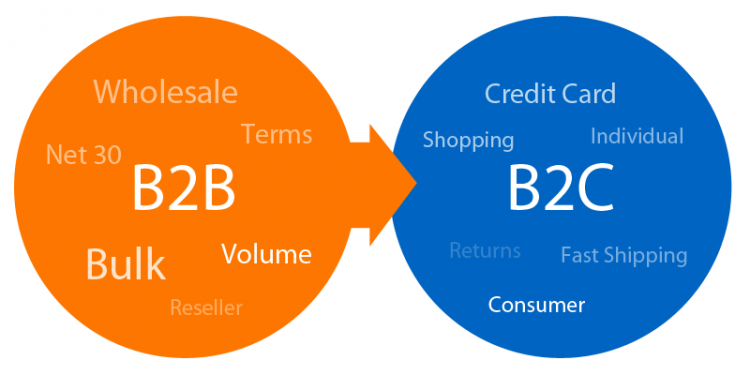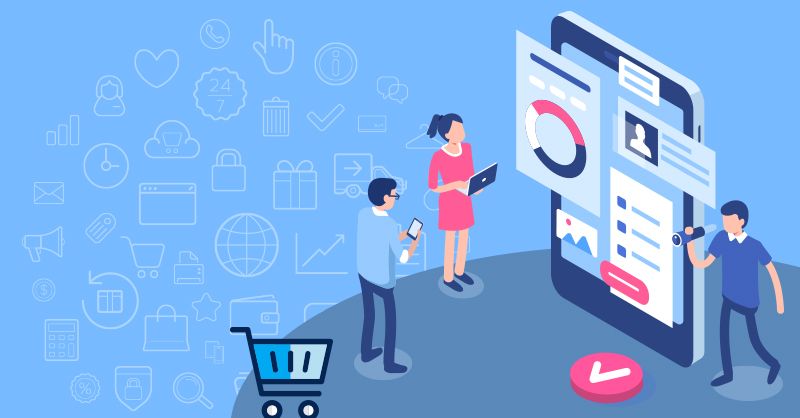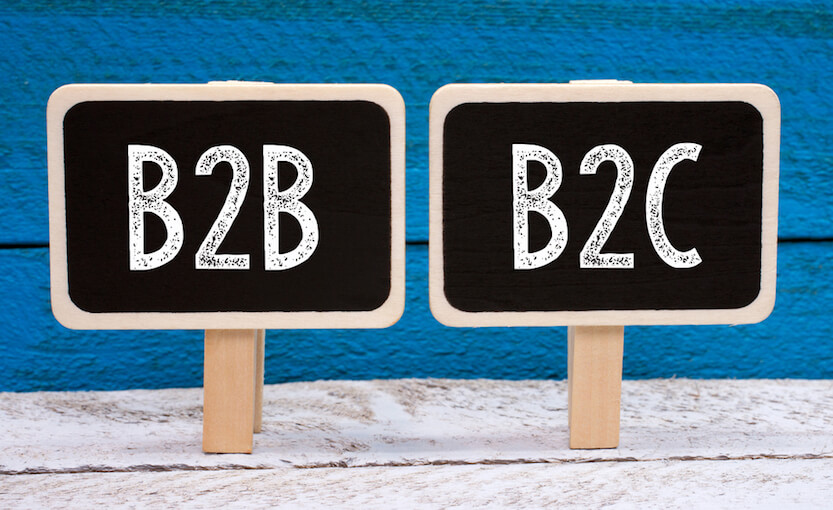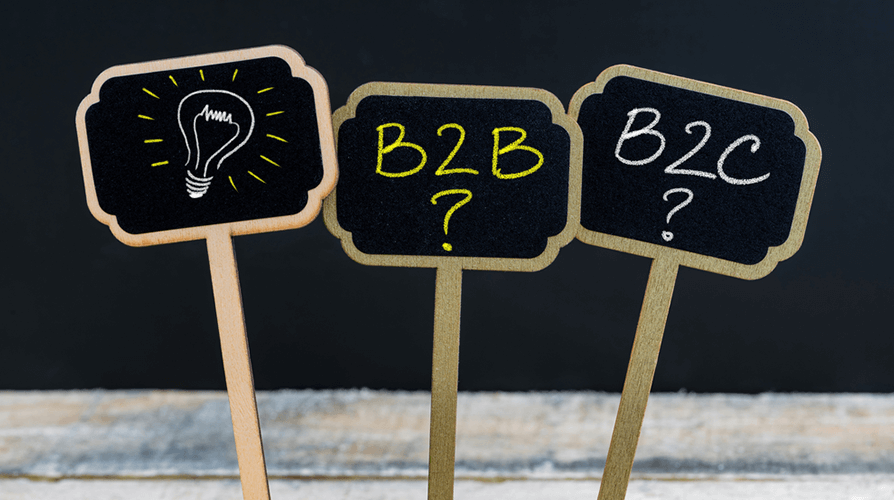WHAT ARE THE MOST IMPORTANT DIFFERENCES BETWEEN B2C ECOMMERCE AND B2B ECOMMERCE?
There are huge differences between B2B eCommerce buyers and consumers compared to ordinary consumer online transactions. B2C tends to be intensely focused on acquisition. The main objective is to get more customers and sell as much as possible.
In B2B, priorities change quite significantly. Large volumes of products are sold here to the same buyer, so the main focus is to keep it. Building and maintaining long-term partnerships is crucial for a B2B-focused supplier. Another critical point is that the B2B buyer is often not the end consumer but a purchasing agent, a specially trained person who makes purchasing decisions.
PLATFORM

To give you an idea of how things are different, some companies make the mistake of creating a B2C eCommerce retailer website with “complementary” B2B resources and then discover that the online store cannot handle the complexity of B2B e-commerce. or with the needs of buyers.
In other words, the needs of B2B eCommerce and B2C e-commerce are so different that it is necessary to analyze which platform to choose before starting online commerce.
WHO IS THE B2B BUYER?
The primary characteristic of the B2B buyers (if compared to average online consumers) happens to be that they are strict ‘professionals.’
They are shopping for a living as part of their job and are mainly concerned with being able to buy quickly.
B2B shoppers are concerned with an efficient, integrated end-to-end shopping process for online and offline shopping. Everything simple and fast with the proper B2B eCommerce development.
WHO IS THE B2C BUYER?
In B2C eCommerce development, a customer needs to be ‘hooked’ with marketing planning for a purchase decision. Still, once the conversion process has started, their needs remain relatively predictable and straightforward.
It is a customer who needs to feel safe, protected, and informed throughout the purchase process. The ease of this process is also essential.
These customers tend to buy with their hearts and not their heads and often buy on promotions in B2C eCommerce.
PRODUCTS

In terms of products, B2B purchases are planned and usually involve large orders. This happens in Shopify, Magento and woocommerce platforms.
They are made to fill empty shelves, not on impulse (like many B2C consumer purchases). Because products can be expensive and complicated (and B2B buyers are under pressure to buy the right product at the right price), price accuracy and product availability are essential. Also, B2B buyers tend to buy after approval by at least 70% of the company’s decision-makers.
B2C consumer products are more straightforward and in less quantity. Some purchases are made on impulse, but many even like to spend a lot of time trying to find the best deal.
DESIGN

The way of using and the website’s design are essential for B2B buyers in terms of the overall shopping experience. For them, the biggest concern is that the website brings the correct details of the products: specific prices, invoices, updated product catalog, easy orders, and sales automation whenever possible.
The B2C client also gives importance to a functional website, but he also likes it to be beautiful. Somehow that page has to hold your attention, whether with offers, design, or beautiful photos.
SMALL ORDERS VS. LARGE ORDERS
Currently, in terms of spending on e-commerce, B2B e-commerce is about twice the size of B2C. Forbes.com predicts that the B2B e-commerce market will be worth $ 6.7 trillion by 2020. As the Shopify, Magento, and woocommerce platform is increasing fast, this is not a new phenomenon.
This is not a big surprise: in addition to the B2B market expanding, B2B orders have much higher average values compare to B2C orders. Typical B2C users spend much less.
• The most significant and most obvious difference between the two retail sectors is sales volume and cash flow.
• B2C customers are buying for themselves or their relatives.
• B2B customers, on the other hand, request large quantities and, therefore, large order values.
• Companies buy more products than end-users and thus are able to negotiate discounts (either on the product price or on the delivery fee).
• This difference in purchasing behavior is significant for e-commerce.
While B2C eCommerce platform customers want to know if a single product is in stock, it doesn’t matter much for B2B customers. They are more interested in quantity and delivery discounts, based on the company’s contract.
CONSUMER PRICES X CUSTOMER PRICES
• For the B2C eCommerce platform customer, prices are already set.
• It doesn’t matter if he has already bought many products or not. Prices are fixed for everyone.
• Within a B2B environment, prices are based mainly on agreements.
• They have specific discounts on certain products.
• They need to be able to buy products at the right price, based on the company they work for.
• In addition to customer-specific discounts, B2B customers may also find different prices.
• Thus, for both normal prices and discounts, B2B e-commerce needs to show the correct prices based on the customer visiting the online store.
• In practice, this can be managed through customer logins.
• Prices may be hidden when a customer has not yet logged in.
• After login, prices are shown based on the company the customer is working for.
STOCK AND DELIVERY
• If B2C e-commerce is running out of stock, this is a big problem.
• Consumers will switch to other online stores to deliver the product faster, even if they are more expensive.
• Therefore, predicting the right quantity of products in stock is a crucial part of B2C.
• For B2B, this is very different: instead of meeting an immediate need, B2B customers often have IT systems that help them place orders on time.
• Therefore, fast delivery is not an essential thing for B2B customers.
• They wish to purchase at the lowest cost. So planned and smart deliveries are more relevant than fast deliveries.
• Therefore, this type of e-commerce must ensure that its customers can choose various shipping methods and show the price differences between them.
• Also, the person responsible for B2B e-commerce must remember that their customers can place orders from anywhere: this changes the costs mainly for goods that are too large or heavy to be shipped using traditional transport services.
• In that case, complete truck shipments can be the right solution.
MULTIPLE BRANDS VS. LONG-TERM RELATIONSHIPS

B2C customers are looking for a specific product, buy, and are likely to visit your online store only after some time. On the other hand, B2B e-commerce is fully integrated into a company’s purchasing department. If everything is going well, it will likely continue to buy from the same supplier for quite some time. B2B buyers are buying products and components online for the survival of their organizations.
LOW-FREQUENCY X REPEATED PURCHASES.
While the typical B2C customer can buy one or two items at a time, it is not uncommon for B2B buyers to purchase hundreds or even thousands of items in one transaction.
B2C consumers are looking for certain products online. They like to visit blogs, watch videos, and read reviews before buying a particular product.
Also, they do not know exactly which product they will buy in the end. They want to be inspired. They want to think and then decide which product to buy. Through eCommerce marketing, this is important.
On the other hand, B2B customers are looking for a specific product. They know precisely what they are looking for, and, for the most part, the B2B buyer is looking for a product code instead of the name.
In B2B, buying online is part of daily tasks. Therefore, this type of e-commerce should be as easy and convenient as possible; time is valuable to them and the company.
46% of B2B shoppers leave an online store due to a lack of accurate information.
CONSUMER GOODS X TYPES OF GOODS
• Almost all B2C online sales are consumer goods such as clothing, watches, jewelry, and electronics.
• B2B sales are very different.
• They are looking for products with more specific information (what are the exact measurements of a screw, for example), contact details (want to discuss specific information that is not yet in the catalog), and much more.
• Therefore, B2B e-commerce needs to display its products based on the wishes of B2B customers.
FOREIGN MARKET VS. SPECIFIC MARKET
• The online B2C market is vast.
• First, large online stores, such as Amazon, are typical examples of online stores focused on a huge variety of consumers.
• They sell books, TVs, washing machines, all together.
• B2B e-commerce is focused mainly on a specific market.
• For example, it is almost impossible to sell parts for all types of machines.
• B2B eCommerce platform sellers are focusing on a niche market and need to cooperate fully with their customers.
• So they understand and satisfy the needs of their customers.
CONCLUSION
While B2C consumers search for broad terms like “big suitcase” and want to be inspired by which to choose, B2B buyers already know exactly what they want. Therefore, for B2B e-commerce, it is essential to include this specific information and ensure that customers can find this information. As you have seen, B2C and B2B eCommerce platformcustomers’ behavior is extensive; they are almost two different things. For you who already work or want to open e-commerce, it is essential to specify which audience you want to sell to.
